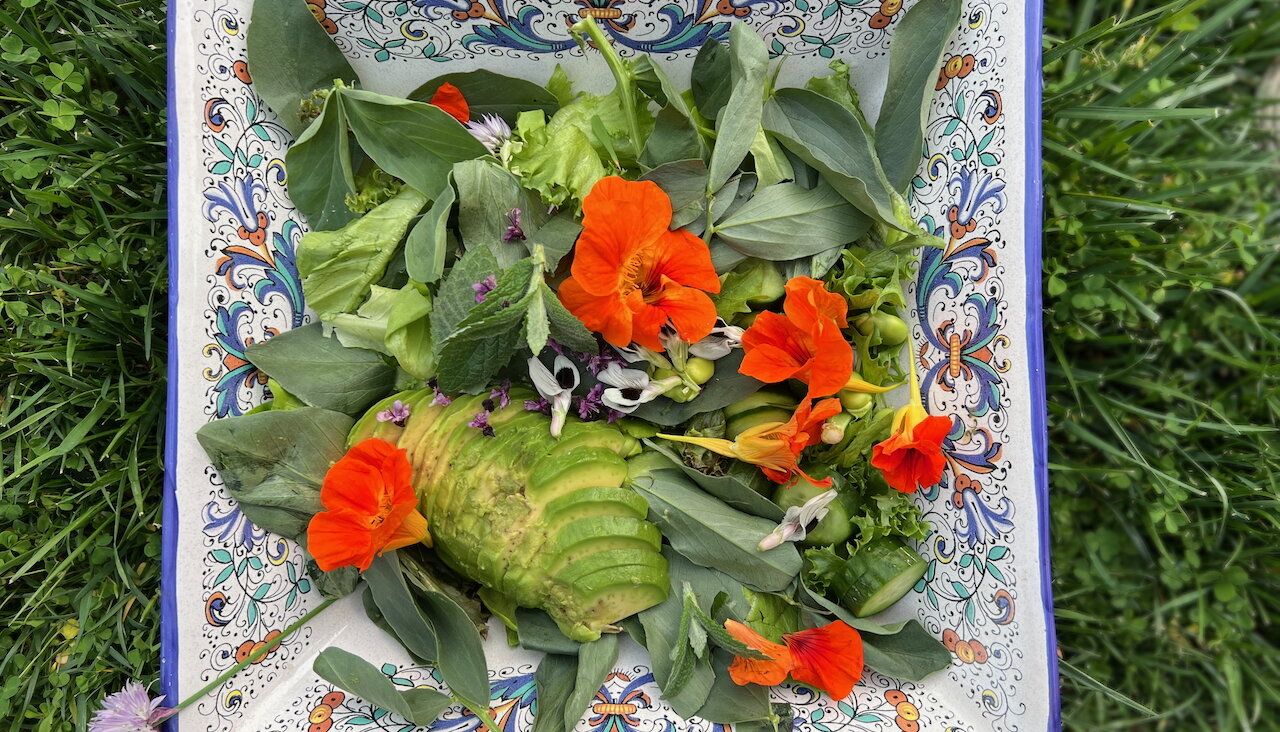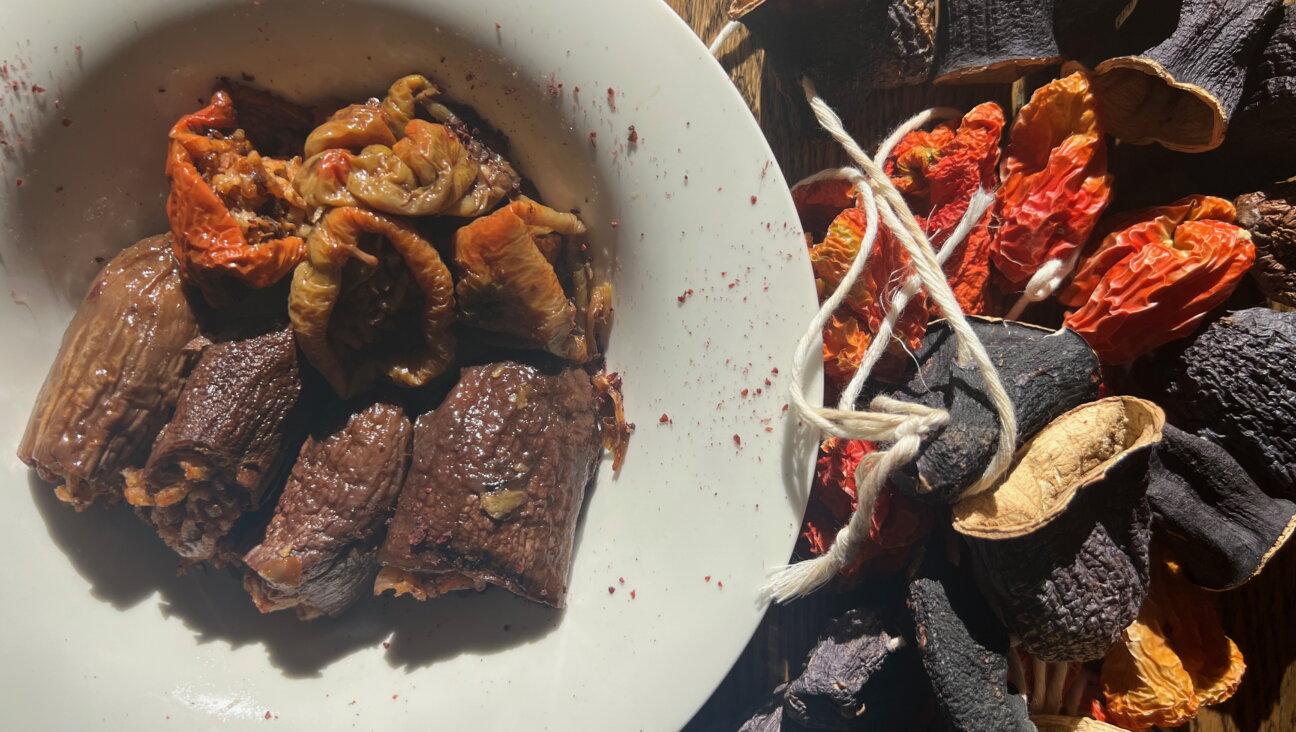The Little Book Of Jewish Feasts Is Bigger Than It Looks

Image by Chronicle Books
Leah Koenig’s “Little Book of Jewish Feasts” may be tiny, but the 25-recipe volume manages to feel deliciously expansive. Here, Koenig, whose previous cookbooks include “Modern Jewish Cooking” and “The Little Book of Jewish Appetizers,” reaches into the lesser-known pockets of the Jewish culinary landscape to unearth surprising recipes for the holiday table.
With photographs by Linda Pugliese of vibrant dishes set dramatically against slate-colored backdrops, this beautiful volume contains a number of recipes that were entirely new to me, though each turns out to be a take on a traditional dish from somewhere in the world.

Image by Leah Koenig
“I’ve been writing about Jewish food for about 10 years now,” Koenig said in an interview, “and the thing that always strikes me is that there’s always a new leaf to turn over. I wanted to honor the fact that this is such a global cuisine.”
In the first section, which is devoted to vegetarian and fish dishes, there is eggplant kuku, a Persian frittata served on Iranian-Jewish tables at Purim and Hanukkah. A black-eyed pea stew called loubia is eaten by Egyptian and Syrian Jews at Rosh Hashanah to symbolize fertility and success in the new year.
In the second section, Koenig introduces meat dishes, including lamb biryani. It likely has Persian roots, she writes. A saucy Iranian dish called fesenjan, comprising chicken, walnuts and pomegranate , is served by Persian Jews on Rosh Hashanah and autumnal Shabbats.
Paging through the book, I quickly found the solution to my regular holiday conundrum of what to serve for Rosh Hashanah when half my guests are vegetarians, one is allergic to fish, and several seem to feel that it isn’t a holiday meal if braised meat isn’t involved. I chose two recipes. The first is a seven-vegetable tagine, traditionally served by Moroccan Jews on Rosh Hashanah because, according to Koenig, “the seven distinct vegetables (which vary from cook to cook) are said to represent the Jewish calendar’s seventh month, Tishrei, which is the month when Rosh Hashanah falls.” Golden raisins add sweetness, which is a hallmark of Rosh Hashanah, she said. And carrots can be sliced like coins, symbolizing good fortune in the coming year.
The second dish I chose is also from North Africa: Mrouzia is a lamb and dried fruit tagine eaten during the Muslim festival of Eid-al-Adha and also served by North African Jews at Rosh Hashanah, “when the sweetness from the honey and dried fruit is particularly symbolic,” Koenig writes.
I imagine serving this hearty meal family style, with guests helping themselves to heaping mounds of couscous and either or both of these savory, aromatic stews — something for everyone, thanks to a tiny book with a big, broad reach across the Jewish holiday table.
Liza Schoenfein is the senior food writer of the Forward. Follow her on Instagram, @LifeDeathDinner

Image by Chronicle Books
Mrouzia (Lamb and Dried Fruit Tagine)
SERVES 6
This sweet and savory tagine is enjoyed throughout North Africa, and is traditionally eaten during the Muslim festival Eid al-Adha. North African Jews, meanwhile, serve it on Rosh Hashanah, when the sweetness from the honey and dried fruit is particularly symbolic. Mrouzia is flavored with ras el hanout, a mosaic blend of spices—typically ginger, cinnamon, cumin, coriander, mace, nutmeg, turmeric, and cardamom, among others—that North African cooks use to perfume their cooking. (It can be found in specialty food shops and online.) Some store-bought ras el hanout blends contain salt and some do not, which makes a difference in the final taste of the dish. Taste the blend to see how salty it is and adjust salt levels in the dish accordingly. Serve the mrouzia over steamed couscous.
1 1⁄2 tbsp ras el hanout
1 tsp ground cinnamon
1 tsp ground ginger
1 tsp kosher salt, or more as needed
1⁄2 tsp freshly ground black pepper
1⁄4 tsp red pepper flakes
1⁄4 tsp saffron threads, crushed
2 1⁄2 lb [1.2 kg] lamb shoulder, cut into 1‑in [2.5‑cm] pieces
1/4 cup [60 ml] extra-virgin olive oil
2 medium onions, halved through the root and thinly sliced
4 garlic cloves, thinly sliced
1 tbsp tomato paste
4 cups [960 ml] chicken stock
2 medium carrots, peeled, halved lengthwise, and cut into 1⁄2‑in [12‑mm] slices
1 cup [160 g] pitted prunes, chopped
1 cup [180 g] dried apricots, chopped
1 cup [120 g] sliced almonds
1⁄4 cup [85 g] mild honey
Chopped fresh flat-leaf parsley for serving
-
Combine the ras el hanout, cinnamon, ginger, salt, black pepper, red pepper flakes, and saffron in a large bowl. Stir in 1⁄4 cup [60 ml] water to make a paste. Add the lamb pieces and stir well to coat. Cover the bowl and refrigerate overnight.
-
Heat the oil in a large Dutch oven or other heavy saucepan with a lid set over medium heat. Add the onions and garlic and cook, stirring occasionally, until the onions soften, 6 to 8 minutes. Stir in the tomato paste, then add the marinated lamb and chicken stock. Turn the heat to medium-high and bring to a boil, then turn the heat to medium-low, cover, and cook, stirring occasionally, until the meat is tender, about 1 hour.
-
Add the carrots, prunes, apricots, 1⁄2 cup [60 g] of the almonds, and the honey and continue cooking, covered and stirring often, until the vegetables are tender, about 30 minutes. Uncover and cook until the liquid has thickened slightly, 10 to 15 minutes. Taste and add more salt, if desired.
-
Transfer to a serving dish and serve hot, sprinkled with parsley and the remaining almonds. Store leftovers, covered, in the fridge for up to 3 days.
Seven-Vegetable Tagine
SERVES 6 TO 8
Moroccan Jews serve this spiced tagine on Rosh Hashanah. The seven distinct vegetables (which vary from cook to cook) are said to represent the Jewish calendar’s seventh month, Tishrei, which is the month when Rosh Hashanah falls. They also signify the abundant bounty of the fall harvest season. The addition of raisins to the dish adds a delightful sweetness, while the chickpeas transform it into a complete vegetarian meal. Serve the tagine over steamed couscous, which soaks up the delicious stew. To streamline the preparation process, measure out all the spices before you start cooking and add them in all at once.
1⁄4 cup [30 g] sliced almonds
1⁄4 cup [60 ml] extra-virgin olive oil
2 medium onions, halved through the root and thinly sliced
4 plum tomatoes (about 1 lb [455g]), seeded and chopped
2 garlic cloves, finely chopped
1 tsp ground cinnamon
1 tsp sweet paprika
1 tsp ground ginger
1⁄2 tsp ground turmeric
1⁄2 tsp ground cumin
1⁄2 tsp ground coriander
1⁄2 tsp red pepper flakes
one 15-oz [430-g] can chickpeas, rinsed and drained
2 zucchini, halved lengthwise and sliced into
1⁄2‑in [12‑mm] half-moons
2 cups [280 g] peeled and finely chopped butternut squash
2 large carrots, peeled, halved lengthwise, and cut into 1⁄2‑in [12‑mm] pieces
1⁄3 cup [45 g] golden raisins
2 1⁄2 cups [600 ml] vegetable stock
Kosher salt and freshly ground black pepper
chopped fresh flat-leaf parsley for garnish
-
Put the almonds in a large pan set over medium-low heat and toast, shaking the pan occasionally, until fragrant and lightly browned, 5 to 7 minutes. Remove the pan from the heat and let cool; set aside.
-
Heat the oil in a medium saucepan set over medium-high heat. Add the onions and cook, stirring occasionally, until softened and lightly browned, 7 to 10 minutes. Add the tomatoes and cook, stirring occasionally, until softened, 3 to 5 minutes. Add the garlic, cinnamon, paprika, ginger, turmeric, cumin, coriander, and red pepper flakes and cook, stirring, until fragrant, 1 to 2 minutes.
-
Add the chickpeas, zucchini, butternut squash, carrots, raisins, stock, 1 tsp salt, and a generous amount of pepper and bring the mixture to a simmer. Turn the heat to low, cover the pot, and cook until the squash and carrots are tender, about 20 minutes. Uncover and continue cooking, stirring occasionally, until the sauce thickens slightly, about 10 minutes. It will still be somewhat liquidy, but should more closely resemble a stew than a soup. Taste and add more salt, if desired. Serve hot, sprinkled with parsley and almonds. Store leftovers, covered, in the fridge for up to 5 days.
Recipes reprinted from Little Book of Jewish Feasts by Leah Koenig with permission by Chronicle Books, 2018
The Forward is free to read, but it isn’t free to produce

I hope you appreciated this article. Before you go, I’d like to ask you to please support the Forward.
Now more than ever, American Jews need independent news they can trust, with reporting driven by truth, not ideology. We serve you, not any ideological agenda.
At a time when other newsrooms are closing or cutting back, the Forward has removed its paywall and invested additional resources to report on the ground from Israel and around the U.S. on the impact of the war, rising antisemitism and polarized discourse.
This is a great time to support independent Jewish journalism you rely on. Make a gift today!
— Rachel Fishman Feddersen, Publisher and CEO
Support our mission to tell the Jewish story fully and fairly.
Most Popular
- 1

Fast Forward Ye debuts ‘Heil Hitler’ music video that includes a sample of a Hitler speech
- 2

Opinion It looks like Israel totally underestimated Trump
- 3

Culture Cardinals are Catholic, not Jewish — so why do they all wear yarmulkes?
- 4

Fast Forward Student suspended for ‘F— the Jews’ video defends himself on antisemitic podcast
In Case You Missed It
-

Opinion It looks like Israel totally underestimated Trump
-

Fast Forward Betar ‘almost exclusively triggered’ UMass student detention, judge says
-

Fast Forward ‘Honey, he’s had enough of you’: Trump’s Middle East moves increasingly appear to sideline Israel
-

Fast Forward Yeshiva University rescinds approval for LGBTQ+ student club
-
Shop the Forward Store
100% of profits support our journalism
Republish This Story
Please read before republishing
We’re happy to make this story available to republish for free, unless it originated with JTA, Haaretz or another publication (as indicated on the article) and as long as you follow our guidelines.
You must comply with the following:
- Credit the Forward
- Retain our pixel
- Preserve our canonical link in Google search
- Add a noindex tag in Google search
See our full guidelines for more information, and this guide for detail about canonical URLs.
To republish, copy the HTML by clicking on the yellow button to the right; it includes our tracking pixel, all paragraph styles and hyperlinks, the author byline and credit to the Forward. It does not include images; to avoid copyright violations, you must add them manually, following our guidelines. Please email us at [email protected], subject line “republish,” with any questions or to let us know what stories you’re picking up.
















